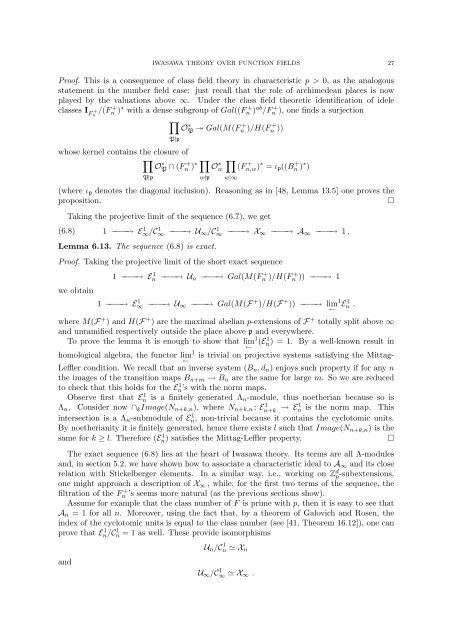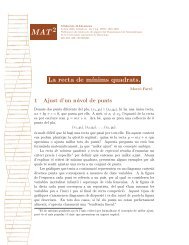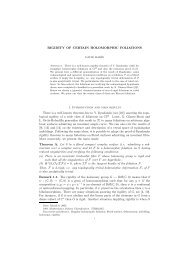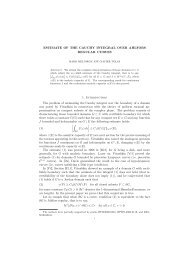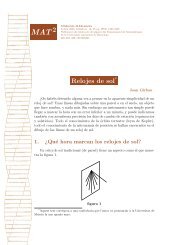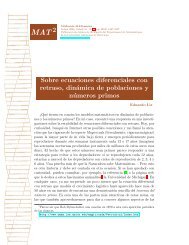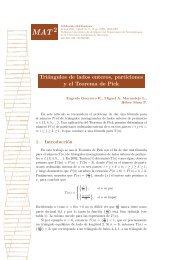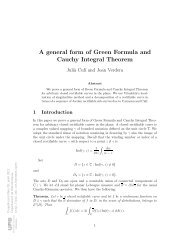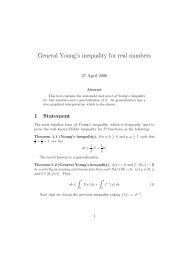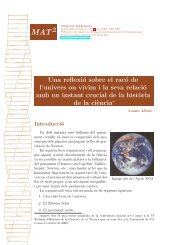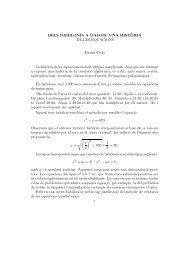ASPECTS OF IWASAWA THEORY OVER FUNCTION FIELDS 1 ...
ASPECTS OF IWASAWA THEORY OVER FUNCTION FIELDS 1 ...
ASPECTS OF IWASAWA THEORY OVER FUNCTION FIELDS 1 ...
You also want an ePaper? Increase the reach of your titles
YUMPU automatically turns print PDFs into web optimized ePapers that Google loves.
<strong>IWASAWA</strong> <strong>THEORY</strong> <strong>OVER</strong> <strong>FUNCTION</strong> <strong>FIELDS</strong> 27Proof. This is a consequence of class field theory in characteristic p > 0, as the analogousstatement in the number field case: just recall that the role of archimedean places is nowplayed by the valuations above ∞. Under the class field theoretic identification of ideleclasses I F+n/(F n + ) ∗ with a dense subgroup of Gal((F n + ) ab /F n + ), one finds a surjection∏OP ∗ ↠ Gal(M(F n + )/H(F n + ))P|pwhose kernel contains the closure of∏P|pO ∗ P ∩ (F + n ) ∗ ∏ w∤p∏(F n,w) + ∗ = ι p ((B n + ) ∗ )Ow∗ w|∞(where ι p denotes the diagonal inclusion). Reasoning as in [48, Lemma 13.5] one proves theproposition.□Taking the projective limit of the sequence (6.7), we get(6.8) 1 −−−−→ E 1 ∞/C 1 ∞ −−−−→ U ∞ /C 1 ∞ −−−−→ X ∞ −−−−→ A ∞ −−−−→ 1 .Lemma 6.13. The sequence (6.8) is exact.Proof. Taking the projective limit of the short exact sequencewe obtain1 −−−−→ E 1 n −−−−→ U n −−−−→ Gal(M(F + n )/H(F + n )) −−−−→ 11 −−−−→ E 1 ∞ −−−−→ U ∞ −−−−→ Gal(M(F + )/H(F + )) −−−−→ lim← 1 E 1 n ,where M(F + ) and H(F + ) are the maximal abelian p-extensions of F + totally split above ∞and unramified respectively outside the place above p and everywhere.To prove the lemma it is enough to show that lim← 1 (E 1 n) = 1. By a well-known result inhomological algebra, the functor lim← 1 is trivial on projective systems satisfying the Mittag-Leffler condition. We recall that an inverse system (B n , d n ) enjoys such property if for any nthe images of the transition maps B n+m → B n are the same for large m. So we are reducedto check that this holds for the En’s 1 with the norm maps.Observe first that En 1 is a finitely generated Λ n -module, thus noetherian because so isΛ n . Consider now ∩ k Image(N n+k,n ), where N n+k,n : En+k 1 → E1 n is the norm map. Thisintersection is a Λ n -submodule of En, 1 non-trivial because it contains the cyclotomic units.By noetherianity it is finitely generated, hence there exists l such that Image(N n+k,n ) is thesame for k ≥ l. Therefore (En) 1 satisfies the Mittag-Leffler property.□The exact sequence (6.8) lies at the heart of Iwasawa theory. Its terms are all Λ-modulesand, in section 5.2, we have shown how to associate a characteristic ideal to A ∞ and its closerelation with Stickelberger elements. In a similar way, i.e., working on Z d p-subextensions,one might approach a description of X ∞ , while, for the first two terms of the sequence, thefiltration of the F n + ’s seems more natural (as the previous sections show).Assume for example that the class number of F is prime with p, then it is easy to see thatA n = 1 for all n. Moreover, using the fact that, by a theorem of Galovich and Rosen, theindex of the cyclotomic units is equal to the class number (see [41, Theorem 16.12]), one canprove that En/C 1 n 1 = 1 as well. These provide isomorphismsandU n /C 1 n ≃ X nU ∞ /C 1 ∞ ≃ X ∞ .


